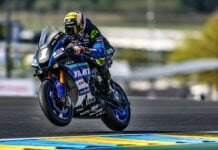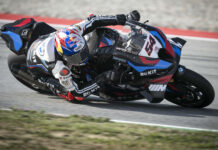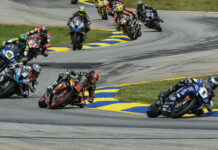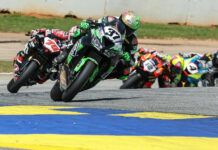FIRST PERSON/OPINION: By David Swarts In January of 2012, AMA Pro Racing announced that it would implement a hardware price cap of $18,000 per motorcycle for engine control and data acquisition electronics in the Superbike class, beginning with the 2013 season and continuing through 2015. The only previous restriction required that hardware be homologated and approved for use by AMA Pro Racing Technical Director Of Competition Al Ludington. But teams say that hardware cost is not the biggest concern, with the cost of buying or developing software and hiring qualified technicians to run the complicated systems making up the bulk of the expense. Yoshimura Racing admits to spending $300,000 per season on electronics hardware, software, development, testing and personnel for its two-rider effort in AMA Pro Superbike. Yoshimura uses Magneti Marelli Marvel 4 systems and employs multiple technicians to run the systems. Monster Energy Graves Yamaha also runs Magneti Marelli Marvel 4 systems on its Superbikes and employs multiple technicians, but says one technician is assigned to run the Magneti Marelli SRT systems it is now running on its Daytona SportBikes! Jordan Suzuki and National Guard Suzuki use Pectel systems run by multiple technicians, while KTM uses Magneti Marelli SRT systems run by a technician who flies in from Italy for each AMA Pro Superbike round. Most of the other Superbike teams use much-less-expensive, much-less-capable, readily available race-kit black boxes (a.k.a. Engine Control Units, or ECUs) that sell for less than $3500 including wiring harness. Examples include Suzuki’s EM Pro system for GSX-R1000s and Yamaha’s YEC system for YZF-R1s. The BMW kit box for the S1000RR sells for about $4000 and plugs into the standard wiring harness. The Kawasaki kit box and wiring harness for the ZX-10R sell for less than $1500. A KTM kit box and setting tool for the RC8 R sells for under $1200. An EBR kit box for the 1190RS sells for $750. Meetings held as recently as June between AMA Pro Racing officials and team representatives have revealed a deep divide in the paddock, with the majority of teams wanting to switch to kit boxes across the board, with a few notable holdouts. AMA Pro officials have openly stated that they established the 2013-2015 rule now on the books based on one winning team’s threat to quit the series if it wasn’t allowed to continue using the Magneti Marelli Marvel 4 system currently fitted to its racebikes. To check where the top-10 players (teams that had put riders in the top-10 in a race and were currently participating) in the AMA Pro Superbike class stood on electronics rules, we posed the following questions: 1. What should the AMA Pro Superbike electronic rules be for 2013-2015 and why? 2. What do you say to someone who claims they need a year or more notice to get ready for any rule change, including switching from the currently allowed advanced electronics to kit boxes? Part 12: In Part 10 of our series on what team owners and managers think the AMA Pro Superbike team rules on electronics should be in 2013 and beyond, Yamaha Motor Corp., U.S.A. Racing Division Manager Keith McCarty said, “There was a big discussion with all of the same group of people long before that rule came into play. So as far as I’m concerned there’s a rule in play, and that’s what we’re going with for 2013.” Although there was much discussion before the 2013-2015 Superbike electronics rule was announced in January of 2012, there was no vote. And the discussion of that rule has continued right along with the struggles of the worldwide economy and the motorsports sponsorship market. In fact, discussions to control costs are ongoing in many racing series, two- and four-wheel, around the world. As recently as during a meeting held at Road America in June, AMA Pro Superbike team managers and owners continued to debate the future of electronics on racebikes. Based on what participants from several teams told us, here are some of the points raised in that debate, followed by counterpoints. Point: Monster Energy Graves Yamaha and Y.E.S. Graves Yamaha Team Owner Chuck Graves has defended his position in favor of allowing advanced electronics in Superbike and Daytona SportBike by saying his team has spent a lot of time and resources making their electronics work and that it would take years for any other team to catch up. Some members of competing teams have paraphrased this as, “The reason we are winning is because we are smarter and we are working harder than the other teams.” Graves has also said that any teams that want to be competitive in AMA Pro Superbike should buy Yamaha racebikes from his company, which also sells Magneti Marelli electronic systems. Counterpoint: Although Yamaha and Josh Hayes are currently winning a lot of races in Superbike, Suzuki still leads the all-time Superbike win list with 169 victories between 1977 and 2012 with most of those earned by the same team, Yoshimura Suzuki. Team owner/rider Larry Pegram has also won Superbike races in recent years. So apparently there are teams–other than Graves Yamaha–that work hard enough and are smart enough to win AMA Pro Superbike races. This part of the argument is a distraction from the real issue, which is saving the entire paddock money. But besides irritating other teams, the comment begs the question: If Graves Yamaha is simply winning because team members are working so much harder and are so much smarter than everyone else, why aren’t they dominating the Daytona SportBike Championship with their Magneti Marelli SRT-equipped YZF-R6s? Point: Chuck Graves has also said that if AMA Pro Racing got rid of the advanced electronics, the results would still be the same, i.e., “The same guys will win.” In other words, Josh Hayes will still win Superbike races on his Graves Yamaha, no matter what the rules. Counterpoint: There’s little doubt that Josh Hayes and Yamaha will continue to win Superbike races with or without advanced electronics. Good for him and good for Graves Yamaha. The primary point of the debate isn’t about who is winning, it’s about reducing costs for the entire paddock, and if nobody had advanced electronics, nobody would need them. That being the case, why should teams that want to have any chance at being competitive be forced to spend hundreds of thousands of dollars on advanced electronics and the technicians to run them? For that matter, why would Graves Yamaha or anybody else want to spend hundreds of thousands of dollars on advanced electronics and the personnel to run them if they didn’t have to? Point: AMA Pro Road Racing Director David McGrath said he was playing “Devil’s advocate” and asked McCarty a very direct question during the meeting at Road America: If the same guys will win no matter what the rules are, what’s the downside to getting rid of advanced electronics? Counterpoint: According to people at the meeting, McCarty said it would cost him more money to switch from the team’s current advanced electronics to readily-available YEC race-kit ECUs that retail for less than $3500. “[McCarty] said the electronics isn’t their biggest cost–they spend more on wheels than they do on electronics,” said Pegram, who then claimed that the money spent on one of the Magneti Marelli dashboards currently used by the Yamaha Superbike team would pay for three YEC race-kit ECUs. Point: Some partisans say that AMA Pro Racing tech inspectors will be unable to tell if homologated race-kit ECUs have been modified internally, allowing some teams to cheat by improving the performance of their race-kit ECUs. Counterpoint: The rule currently scheduled to take place for 2013 requires AMA Pro Racing to determine if the advanced electronic systems actually installed on racebikes are the same as the advanced electronic systems homologated as coming in underneath the hardware price cap. The advanced systems allowed under the price cap are vastly more complicated and more capable than race-kit ECUs. If AMA Pro Racing cannot effectively police race-kit ECUs, how will it be able to police the advanced electronics? And if AMA Pro Racing cannot police either type of ECU, isn’t the paddock better off with the less expensive, less capable option, which will support less internal tweaking? Point: Some have said that mandating race-kit ECUs would not be fair because BMW’s race-kit ECU is more advanced than race-kit ECUs currently sold by Eric Buell Racing, Kawasaki, KTM, Suzuki and Yamaha. Counterpoint: This may or may not be true. The problem is that the advanced electronics currently being used are trillions of light-years ahead of the race-kit ECUs that some teams are running. Mandating race-kit electronics for all will at least put teams within the same solar system in terms of system capability, and will reduce the cost of being theoretically competitive. Point: Some say that changing the Superbike electronics rule now, seven months before the start of the 2013 season, will not give teams enough notice to properly prepare. Counterpoint: Race-kit ECUs are plug-and-play and can be quickly installed and operated by any competent mechanic, no geek required. It should be child’s play to install and sort out a race-kit ECU for the teams currently running advanced electronics and employing technicians to run those electronics. Beyond that, MotoGP organizers have just announced that CRT motorcycles will be required to use a spec ECU in 2013, giving teams roughly an equal amount of notice. And consider this: Attack Performance’s Richard Stanboli built a MotoGP CRT racebike from the frame up in four months, including installing and figuring out the latest MoTec engine control electronics for the first time. If he can do it, surely the other teams currently running advanced electronics team can do it! Point: AMA Pro Racing Technical Director Al Ludington has asked what he should tell the mothers of AMA Pro racers who get hurt if advanced electronics are banned. Ludington’s point seemed to be that banning advanced electronics would make Superbikes more dangerous to ride. Counterpoint: Since the British Superbike Championship’s switch this season to control ECUs without traction control or other any rider aids, there have been no additional safety problems and no spike in rider injuries in both wet and dry races. Riders have supported and have made positive comments about the change. To be continued…
Superbike Electronics: AMA Pro Team Managers Talk About What Rules Should Be For 2013 And Beyond, Part 12
Superbike Electronics: AMA Pro Team Managers Talk About What Rules Should Be For 2013 And Beyond, Part 12
© 2012, Roadracing World Publishing, Inc.






